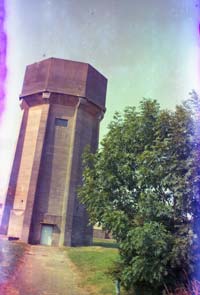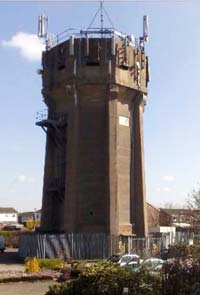Kodak Six-20 Folding Hawk-Eye
Specification

| Manufacturer | : | Eastman Kodak, Rochester N.Y. |
|---|---|---|
| Produced | : | 1933 - 1934 |
| Classification | : | Medium Format |
| Body Type | : | Folding Bed |
| Bellows Deployment | : | Self Erecting |
| Construction | : | Metal |
| Film Type | : | 620 |
| Film Width | : | 62mm |
| ImageSize | : | 2¼ x 3¼ in |
| No. of Images | : | 8 |
| Lens Type | : | Kodak Anastigmat |
| Focus Type | : | Variable |
| Focal Length | : | 85mm |
| Focal Range | : | 3ft - inf. |
| Aperture Type | : | Stops on rotary plate |
| Aperture | : | f/11, f/16, f/22, f/32 |
| Shutter Type | : | No.0 Kodal H-E |
| Shutter Speeds | : | T,I*(1/40 sec) |
| Size Closed (w x h x d) | : | 80 x 150 x 33 mm |
| Size Open (w x h x d) | : | 80 x 150 x 125 mm |
| Weight | : | 488g |
| * Measured on this camera | ||
Art Deco Credentials
![]()
![]()
![]()
Noteworthy: Worth giving special attention
- Produced during the main Art Deco period.
- Octagonal face plate with chrome circles.
- Ornate chrome struts.
- Pig-grained leatherette
- Chrome film winder
- Chrome and black enamel brilliant finder
- Chrome back latch
Description
The Six-20 Folding Hawk-Eye was introduced in 1933. It is a self-erecting folding camera which is covered with pig-grained leatherette. The shutter plate is octagonal with chrome circles on black enamel. The struts are chrome and ornate. It has a brilliant finder that swivels to cater for both portrait and landscape views. It has a swiveling red window cover. A tripod mount is provided on the folding bed. It does not have a folding frame finder.
The shutter is a T/I type but only has one speed. The f/11 meniscus lens can be stopped down using stops on rotary plate to provide aperture values of f/11, f/16, f/22 and f/32.
How to Use
This camera takes 620 film which is still available from selected photographic outlets. Although the actual film is the same as 120 film, the spools are different. The 620 spools are slightly shorter and have a smaller diameter. Do not use 120 film in this camera because it will jam and may snap. It is possible to cut down a spool of 120 film to fit or to re-spool some 120 film onto 620 spools in a darkroom or changing bag.
The camera has four aperture settings numbered 1 to 4. These are f/11(1), f/16(2), f/22(3) and f/32(4) which are changed using a rotating wheel found below the face plate. With a shutter speed of only 1/40 sec, make sure you brace the camera against your body or something solid and press the shutter smoothly to avoid camera shake. There is a tripod socket.
If you don't want to bother with an exposure meter, follow the guide below. It is based on the 'Sunny 16' rule. Film is so forgiving and will produce acceptable results even when over-exposed by 2 or 3 stops or under-exposed by 1 stop.
The tables below assume the shutter speed is about 1/40s. If you are not sure about the light level, err on the side of overexposure - i.e. assume the lower light level.
The tables also assume that the sun is at least 30 degrees above the horizon - that's 10am - 5pm on a summers day (May - August) in the UK.
I recommend ISO 400 film in this camera.
Using ISO 100/125 Film
| Weather Conditions | Shadow Detail | Aperture | Exposure |
|---|---|---|---|
 Sunny SunnySnow/Sand | Dark with sharp edges | f/32(4) | Good |
 Sunny Sunny | Distinct | f/22(3) | Good |
 Slight Overcast Slight Overcast | Soft around edges | f/16(2) | Good |
 Overcast Overcast | Barely visible | f/11(1) | Good |
 Heavy Overcast Heavy Overcast | None | f/11(1) | -1 Stop Underexposed Acceptable |
 Open Shade Open Shade/Sunset | None | f/11(1) | -2 Stops Underexposed Not Acceptable |
Using ISO 400 Film
| Weather Conditions | Shadow Detail | Aperture | Exposure |
|---|---|---|---|
 Sunny SunnySnow/Sand | Dark with sharp edges | f/32(4) | +2 Stops Overexposed Acceptable |
 Sunny Sunny | Distinct | f/32(4) | +1 Stop Overexposed Acceptable |
 Slight Overcast Slight Overcast | Soft around edges | f/32(4) | Good |
 Overcast Overcast | Barely visible | f/22(3) | Good |
 Heavy Overcast Heavy Overcast | None | f/16(2) | Good |
 Open Shade Open Shade/Sunset | None | f/11(1) | Good |
Photographs taken with this Camera
To be fair, the image was found in the camera when I bought it. It was using Kodacolor II which became obsolete in 1983. There has been some colour shifting over the years. This was the first general purpose consumer colour film using the new C-41 process. Initially ISO 80 but increased to ISO 100 from 1975.
No idea when the image was taken but presumably in the early 80s. For those that might be interested, I found the water tower. It's the Eaton Socon Water Tower in St Neots, Cambridgeshire UK. Now supporting Communication masts. The second image was not taken with this camera.

